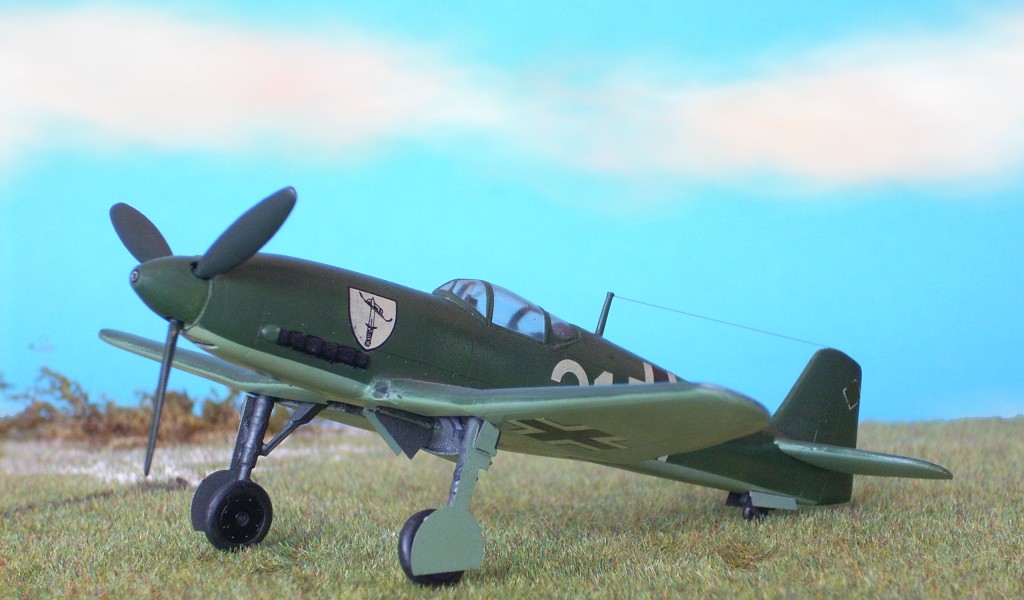
Heinkel He 100
| Manufacturer: | Kit: | Quality: |
MPM |
Heinkel He 100 D-1 |
|
|
Die Heinkel He 100 war schneller und wendiger als die konkurrierende Messerschmit Bf 109, jedoch hatte Willy Messerschmitt eindeutig den besseren Draht zum Reichs-Luftfahrt-Ministerium als Ernst Heinkel. So kam es, daß die He 100, trotz des am 30.03.1939 erzielten absoluten Welt-Geschwindigkeitsrekordes, nicht von der Luftwaffe in den Truppendienst übernommen wurde. Was nicht heißt, daß die He 100 nicht im WK 2 im Einsatz gewesen wäre; das war dieses Flugzeug sehr wohl, und zwar gleich in zweierlei Hinsicht. Zum einen wurden die von Heinkel produzierten 12 Stück He 100 D-1 stätionär zum Schutz der Heinkel-Produktionsanlagen eingesetzt, andererseits dienten eben diese Flugzeuge auch der Nazi-Propaganda als "das neueste Jagdflugzeug der Luftwaffe - die He 113" was reine Fantasie war (ebenso wie die Kennungen). Ein weiterer Grund, warum die He 100 es nicht in den Truppendienst schaffte, war das von Heinkel bevorzugte Kühlverfahren mittels Oberflächenverdunstung, was sich aber in der Praxis als untauglich erwies und in den Serienmaschinen von konventioneller Kühlung ersetzt wurde. Nachdem die He 100 von Werkspiloten im scharfen Einsatz geflogen worden war, steht dementsprechende Feindberührung anzunehmen, auch wenn keine Abschüsse verbürgt sind. Die Heinkel He 100 ist in bester Heinkel-Tradition gefertigt; gibt es doch kaum ein Flugzeug von Ernst Heinkel, das nicht die charakteristische elliptische Tragflächenform aufweist. Was mit der Heinkel He 70 und He 112 begann, bei He 111 aus produktionsgründen zu einer geraden Tragflächenvorderkante führte, wurde konsequent auch bei der He 100, dem zweimotorigen Nachtjäger He 219 und sogar bei Heinkels Düsenjäger, der zweistrahligen He 280 (welche noch vor der Me 262 flog) umgesetzt. Zu welchen Leistungen solche (halb-)ellipitschen Tragflächen befähigen, sieht man auch an Flugzeugen wie der Supermarine Spitfire und der Hawker Tempest. Das Modell setzt die realen Vorgaben recht wahrheitsgetreu um, die He 100 war ein sehr kleines und zierliches Flugzeug. Der Bausatz glänzt durch Fotoätzteile für Fahrwerksklappen, Instrumentenbrett, Ruderpedale und Gurten. Ich ergänzte noch das Visier. Die Nachteile sind das Fehlen jeglicher Innenstruktur in Cockpit und den Fahrwerksschächten. Die Bemalung erfolge streng "nach Vorschrift", die Kennungen und Markierungen stammen aus dem Bausatz. |
The Heinkel He 100 was faster and more agile than the competing Messerschmitt Bf 109, but Willy Messerschmitt was the one, who had the better connections to the Reichs-Luftfahrt-Ministerium (Air Ministry) than Ernst Heinkel. No wonder, that the He 100, inspite of reaching the absolutely speed-world-record on March 30 One further reason, why the He 100 was not in active service by the Luftwaffe was, that Heinkel preferred a cooling-system based on evaporation on the aircraft's surface, which proved to be ineffectual in practice and had to be replaced by conventional cooling on the production aircrafts. After the He 100s having been piloted by Heinkel's aircraft-personnel in armed action indeed, adequate action of contact is to be assumed , even there are no historical facts of any enemy scores. The He 100 is poduced in best Heinkel-tradition; there was nearly not one aircraft desgined by Ernst Heinkel, lacking the characteristically elliptic shape of wings. What was begun with the Heinkel He 70 and the He 112, changing to straight-lined wings leading-edges on the He 111 in order to faster production, was consequently permuted on the He 100, He 112, the two-engined He 219 night-fighter, and even on Heinkel's first double jet-propelled He 280 (which had it's maiden flight even before the Me 262). To which effort such (half-)elliptic wings are empowering, is clearly shown on aircrafts as the Supermarine Spitfire or the Hawker Tempest. The MPM-kit is transcribing the real demands rather well, the He 100 was a very tiny and graceful aircraft. The kit's highlights are the etched brass for the wheel-well-doors, instrument panel, rudder-pedals and seat-belts.I added a self-made gun-sight. The kit's disadvantages are the lack of any inner structure inside the cockpit and the whell wells. Camouflage was done strictly following the "service regulations", markings and codes were added to the kit. |
Further pictures